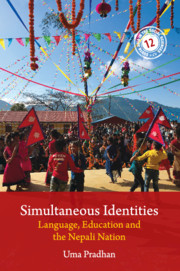Book contents
- Frontmatter
- Contents
- List of Figures
- List of Tables
- List of Appendices
- List of Abbreviations
- Acknowledgements
- Notes on the Use of Terms, Transliteration and Names
- Introduction: Language, Education and the Nepali Nation 1
- 1 Language, Education and State-Making in Nepal
- 2 Mother Tongue and the Construction of an Educated Person
- 3 Language, Public Space and Identity
- 4 Transforming Language to a Script
- 5 Language, Education and Knowledge-Making
- 6 Quality, Equality and Language Ideology
- 7 Ethnicity, Education and Employment
- Conclusion: Simultaneous Identities
- Appendices
- Glossary
- Bibliography
- Index
3 - Language, Public Space and Identity
Published online by Cambridge University Press: 30 April 2020
- Frontmatter
- Contents
- List of Figures
- List of Tables
- List of Appendices
- List of Abbreviations
- Acknowledgements
- Notes on the Use of Terms, Transliteration and Names
- Introduction: Language, Education and the Nepali Nation 1
- 1 Language, Education and State-Making in Nepal
- 2 Mother Tongue and the Construction of an Educated Person
- 3 Language, Public Space and Identity
- 4 Transforming Language to a Script
- 5 Language, Education and Knowledge-Making
- 6 Quality, Equality and Language Ideology
- 7 Ethnicity, Education and Employment
- Conclusion: Simultaneous Identities
- Appendices
- Glossary
- Bibliography
- Index
Summary
‘Jwajalapa!’ A group of students on the playground greeted me as I entered JSB. The big board, with school name written on it, clearly mentioned that the school used Nepal Bhasa as the medium of instruction. As more students approached me, I replied ‘Jwajalapa’, with a bit of awkwardness. The most common greeting in Nepal is ‘Namaste’, the one that I was most comfortable with. Jwajalapa is a fairly recent practice that has been revived and popularised as a genuinely Newari greeting. As more students came out from classrooms, some greeted me with ‘Namaste’ and ‘Good morning’. Mirroring their greetings, I continued to reply with various combinations of ‘Jwajalapa’, ‘Namaste’ and ‘Good morning’. Within the first few minutes in the school premise, I had encountered several languages contrary to my naïve expectation to see and hear Nepal Bhasa exclusively in this school known for mother tongue education. As I learned later, the students also used namaste in informal communication and ‘good morning/afternoon’ in the classroom, though jwajalapa is used more often in official communication, formal conversations and during Nepal Bhasa lessons.
This practice is considered to be in line with the Nepali state's definition of mother tongue education. According to the Inclusive Education Information Booklet published by the GoN, ‘If the language-spoken-at-home is used for language of instruction in school, such education is understood as mother tongue education’ (DoE, 2003: 13; MoE, 2003b). Here, the languages hitherto confined within the private spaces of the home, family and personal relationships were called on for the use in public places such as schools. The political significance of these schools was that they also enacted the right to mother tongue guaranteed for in the Constitution of Nepal. Drawing on these legal provisions, in JSB, the school consciously worked to institute Nepal Bhasa, the language that has seen a decline in use by the younger generation, through everyday use in school education. In JKHSS, the school drew on the existing linguistic use of Tharu to make new collaborations and negotiate its status as the official language of instruction. However, as I will illustrate in this chapter, the students and teachers used a combination of various languages that included mother tongue, Nepali and some amount of English; dressed up in ethnic attire; and held Nepali flags while participating in public programmes and articulating ethnic language and identity as their national identity.
- Type
- Chapter
- Information
- Simultaneous IdentitiesLanguage, Education, and the Nepali Nation, pp. 92 - 112Publisher: Cambridge University PressPrint publication year: 2020



